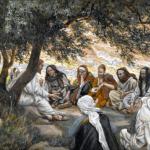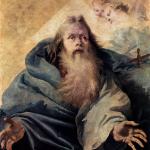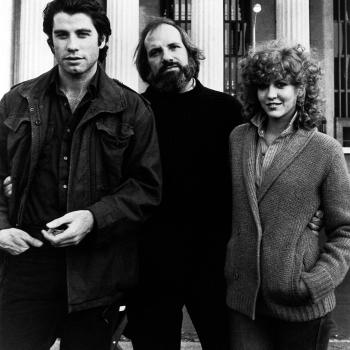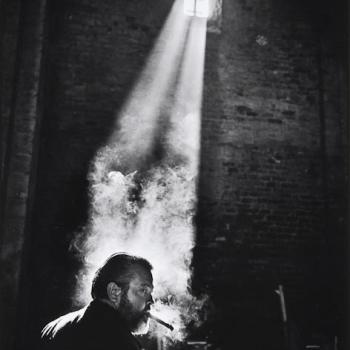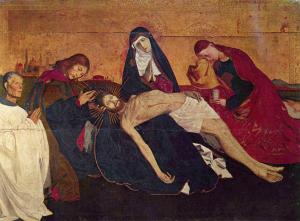
On the one hand, this might seem a sort of silly question. Who cares what counts as religious art? When one sees a giant depiction of Jesus Christ, it’s safe to assume one is dealing with it. Other forms might present some complexities, maybe even a few outliers, but, on the whole, what you see is what you get.
I am not, however, just interested in discussing visual art. What makes for a religious book? Poem? Film? One could go on and on. The question has all the more immediacy because there’s a tendency these days to decry all forms of Modern art as useless, godless, and ugly. Among Catholics, there’s a noticeable desire to turn to older forms—typically Renaissance and Early Modern ones in the aftermath of much post-Vatican II church building. While these impulses do not always go together, it is certainly not uncommon to hear one degraded while a sort of return is countenanced. What if social conditions today could be appropriated for religious purposes as well?
To assume they cannot is, I think, a sort of mistake. For one, to do so elides the distinction between popular and other forms of art within the premodern and Early Modern worlds. There was plenty of bawdy stuff; it wasn’t all pristine religiosity. Additionally, to do so simply misunderstands how it is that religious art can function within a society such as our own, one not predominantly populated by, well, religious people (N.B. given that this is a Catholic blog, my examples here will concentrate on Catholicism, though I imagine the basic concepts could be applied to most other religious groups).
There are, in practice, two sorts of religious art. First and foremost there is that put up in churches within an explicitly religious context, whether visual or textual. This would include stained glass, the mime plays sometimes put on during medieval sermons, and even the vestments of the clergy. These are not my focus today, since their function is explicitly didactic and laudatory; they necessarily communicate to a limited community (this is, in part, why just putting them outside the church does not work as a means of “popularizing” religious art).
People make other sorts, however. Think of the Lord of the Rings books—implicitly religious without any “overt” Christian symbolism. Think, perhaps a bit more offensively, about Francis Bacon’s Head VI, which, while itself not by a religious artist, plays with the existence of a religious tradition to achieve its effect. What about Andy Warhol’s The Last Supper? As these examples show, art can appropriate religious imagery for other purposes or mask its religious didacticism by popular ways. This, as we will see, may be the key to understanding (and publicizing) religious art today.
To my mind, both of these sorts of such art are necessary in today’s world. Purely didactic or laudatory religious art is directed at a cohesive community, a set of individuals gathered for a specific, religious reason. It works in churches. There is nothing wrong with it (at all) and, it, of course, can successfully convince people to become religious within certain contexts. But this is not its primary function—to truly understand the intricacies of iconography, or to know the stories of the life of Christ from stained glass—these require oral or textual edification. The tropes used are rooted in existing traditions with which the average viewer or reader is unfamiliar. In short, in spite of its beauty, it often elicits confusion.
Linking past to present, I see this everyday as a grad student working in the field of medieval literature. There are certain poets, for example, who were wildly popular (by the standards of the time anyway) in their own day, but whose work now meets a more-or-less universal “meh.” Part of this has to do with changing conceptions of poetry, but part of it is merely that the implied audience was different for the earlier writer. John Lydgate serves as a good example. He was a Benedictine monk who likely knew Chaucer. In the 15th century, he became fairly famous, working for some of the most important patrons of the day and producing a massive output of some 145,000+ lines of poetry. His popularity endured for some time, with many seeing him as second only to Chaucer in the canon of early English literature. Eventually his fame tapered off; he never got it back. Why? Because, unlike Chaucer, who characteristically developed a deeply ironic sense, worked in a variety of forms, obsessively thought in terms of narrative, and who (in some important ways) broke with medieval poetic sense, Lydgate is the archetypal medieval writer who loves amplificatio, occupatio, and the like. His poems are long, sometimes with dozens of lines making the same point over and over again in different words as a means of celebrating or amplifying that idea’s importance. A brief example:
Beholde, o man! lyft up thyn eye and see
What mortall peyne I suffre for thi trespace.
With pietous voys I crye and sey to the:
Beholde my woundes, behold my blody face,
Beholde the rebukes that do me so manace,
Beholde my enemyes that do me so despice,
And how that I, to reforme the to grace,
Was like a lambe offred in sacryfice.And geyn thi pryde behold my gret mekenesse;
Geyn thyn envie behold my charité;
Geyn thi leccherye behold my chast clennesse;
Geyn thi covetyse behold my poverté.
Atweene too thevys nayled to a tree,
Rayled with reed blood, they lyst me so desguyse,
Behold, O man! all this I did for the,
Meke as a lambe offred in sacryfice.Behold my love, and gyf me thyn ageyn;
Behold, I deyde thy raunsom for to paye.
Se howe myn herte is open brode and pleyn,
Thy gostly enemyes onely to affraye.
An hardere batayle no man myght assaye,
Of all tryumphes the grettest hye empryse.
Wher-for, O man! no lenger to dismaye,
I gaf for the my blood in sacryfice.Turne home ageyn, thy synne do forsake.
Behold and se yf ought be left behynde,
How I to mercy am redy the to take.
Gyf me thyn herte and be no more unkynde;
Thy love and myn, togedyr do hem bynde,
And late hem never departe in any wyse.
Whan thou were lost, thy sowle ageyn to fynde,
My blod I offred for the in sacryfice.Emprente thes thynges in thyn inward thought,
And grave hem depe in thy remembraunce;
Thynke on hem, and forgete hem nowght.
Al this I suffred to do the allegeaunce,
And with my seyntes to yeve the suffisaunce,
In the hevenly court for the I do devyse
A place eternall, a place of all plesaunce;
For which my blood I gaf in sacryfice.


